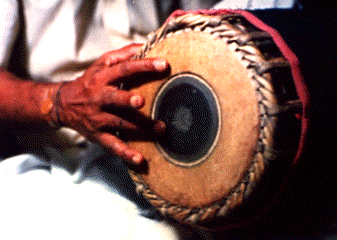|
The mridangam is played
primarily by using the index, middle, ring and small
fingers of both hands while the thumb finger is used as
a support element. The palm of the right hand is also
used mainly while playing the stroke "plam or
jham". To play the strokes "nam" and
"dhim", it should be kept in mind that when
the index finger is used to play these strokes, the ring
finger should always be positioned in between the
outer rim and the inner black ring on the right side of
the mridangam (fig.1).
The stroke "thi" is played by using the
middle, ring and small fingers of the right hand in the
centre of the black area on the right side of the
mridangam but it should be noted that these three
fingers should be held together while playing this
stroke. Even while playing the stroke "jham",
these three fingers should be held together. The stroke
"ta" is played by using the index finger of
the right hand at the centre of the black area on
the right side of the mridangam.
|

Fig. 1
|